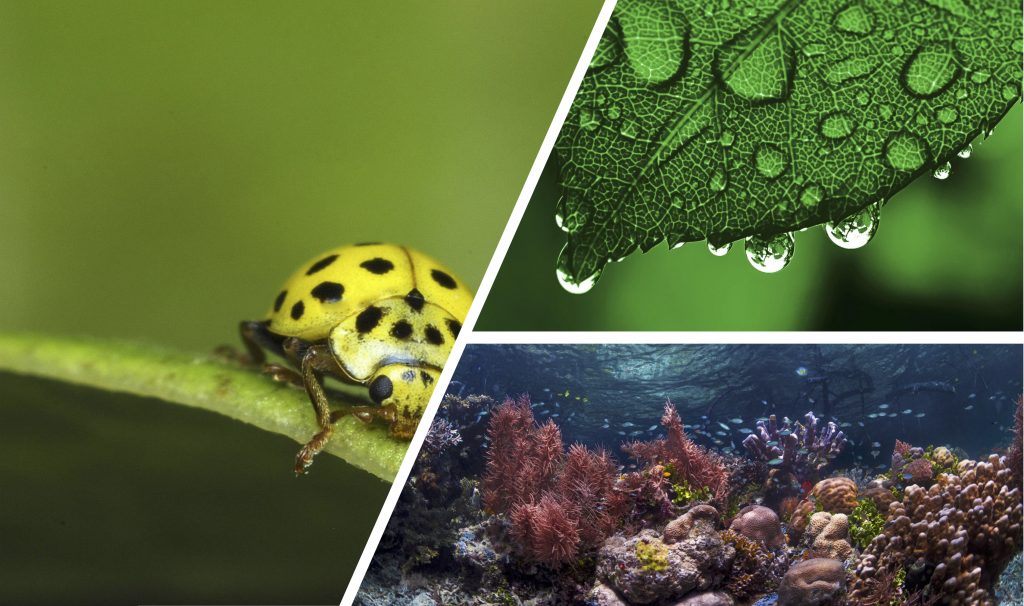Biodiversity
Biodiversity is a measure of the diversity of life. In its simplest form, it describes the number of different living organisms in a system. It can address all organisms in the system or a selected type of organism, like bacteria. Therefore, biodiversity is a concept that describes the variety of life.
A microbiome community includes a range of different microorganisms and we often use biodiversity to describe the health and functional capacity of these communities. Sequencing technologies can be applied to identify the bacteria or fungi in a sample and calculate the diversity of its microbiome community. When we do so, we talk about “alpha diversity”. See more below on how we measure alpha diversity as a measure of biodiversity or biotic diversity.
The concept of biodiversity
Biodiversity can describe the diversity of living organisms in a larger environment like the ocean, in a more specific location like a lake, field, or forest, but also the diversity of a type of organisms like plants, fishes, or microorganisms. Biodiversity can also broadly describe the general variety of life on earth through different ecosystems on the planet, such as deserts, rainforests, and coral reefs. Furthermore, biodiversity considers the diversity within a species, such as its genetic diversity and many dimensions must thus be considered when fully assessing biodiversity.
Therefore, what is exactly meant by biodiversity depends on the connection in which the term is used.
People concerned with the quality of freshwater lakes will discuss the diversity as the number of different fish in the water and perhaps include information on the total number of fish. Or they will discuss the number of different microorganisms in the water well knowing these tiny living organisms are important indicators for the quality of the water.

Biodiversity and sustainability
The term biodiversity will often be heard in connection to discussions of sustainable farming, pollution, and climate changes. This is because pollution and climate change are known to reduce the diversity of living organisms on the planet, and in environments like the soil and water. Biodiversity enhances the productivity of an ecosystem – because each species, no matter how small, has an important role to play.
In ecology, involving the interaction between living organisms, concepts such as cooperation and competition are important and we recognize how “survival of the fittest” is important to keep a balanced ecosystem. Despite the competition between species, each species depend on the services provided by others to survive. Appropriate conservation and sustainable development strategies, therefore, recognize the need to preserve and increase biodiversity.
Declining biodiversity is a concern for many reasons. In recent years the reduction in the diversity of insects has been a highly discussed topic, especially with a focus on the reduction in the number of bees due to high usage of pesticides.
News channels around the world have not dedicated their time to discussing the reduction in the numbers and diversity of bees solely due to our liking for honey. A statement from the German bee expert Professor Joergen Tautz from Wurzburg University made the importance of bees to our ecosystem very clear when he in an interview stated:
“Bees are vital to biodiversity. There are 130,000 plants for example for which bees are essential to pollination, from melons to pumpkins, raspberries, and all kinds of fruit trees — as well as animal fodder — like clover. Bees are more important than poultry in terms of human nutrition.”
The Telegraph, March 14, 2007
Humans are using an increasing fraction of the earth’s surface for farming. While this is necessary to feed the growing population, it is also causing serious risks to our ecosystems and the biodiversity of the nature around us. When a single crop is grown on a field, the diversity of the field is drastically reduced. As a consequence, many plants that are not used for human or animal food, but which are important for our ecosystem, are having a hard time finding a place to grow.
This reduces both the diversity of plants and insects, as well as bigger animals living wild in nature, as their natural habitats are reduced. But also, the diversity of the smaller organisms, the microorganisms in the soil, is suffering. The fertilization, use of pesticides, and intense usage of the soil cause the diversity of microorganisms to decline. This has the critical consequence of reducing the health of the soil and its ability to support the production of plants for food for the world’s larger living beings.

FREE: Get our Checklist for collecting soil for microbiome profiling
Fill out the information below, and download our checklist.
How Biomcare measure microbial diversity or biotic diversity in a sample
When we sequence the DNA of microorganisms using one of our sequencing solutions, we identify the different organisms and measure their abundance. With this data, we can calculate different measures of diversity. We refer to these measures as alpha diversity – a measure of the within-sample diversity, not to be confused with beta-diversity which is a measure of the difference between the microbiome community of two samples.
Alpha diversity as a measure of biodiversity
Many different measures of alpha diversity have been proposed. However, they all fall within one of the following groups:
- Richness – the number of different species in a given sample
- Inferred richness – the number of different species in a given sample, when considering the organisms that we did not detect due to technical limitations.
- Evenness – the degree to which the relative abundances of the different species in the sample are similar
- or a combination of richness and evenness – that is measures that consider both richness and evenness
At Biomcare we calculate several different measures to cover the different interpretations and make sure we fully elucidate the properties of the biodiversity in a given sample. When we have calculated alpha diversity, we apply statistics to understand if the diversity is significantly different between conditions or associated with an external factor of interest.
Biodiversity is key for agriculture
The interaction between soil, plants, and microorganisms, including bacteria and fungi, is fundamental for the plant’s ability to take up nutrients from the soil. In turn, the diversity of microorganisms in the soil is key to effective agriculture. Soil degradation by pollution, depletion, contamination, salinization, etc., destroys the habitat of soil organisms and causes soil biodiversity to decrease. Key factors of management practices that reduce soil diversity include reduced deposition of organic matter and the sidestep of naturally occurring nutrient cycling by microorganisms.
One key example of the importance of soil biodiversity is the role of microorganisms in the nitrogen cycle. Nitrogen is found in the environment in several different chemical forms such as organic nitrogen, ammonium, nitrite, nitrate, or inorganic nitrogen gas. Organic nitrogen is found in living organisms such as plants and animals, in humus, or intermediate products. In the nitrogen cycle, nitrogen is transformed from one form to another, and many of those transformations are carried out by microbes. Microorganisms carry out the processes of transforming nitrogen for their benefit, but the processes are essential for the cycling of the important building block. Of key importance to farming is the breakdown of the nitrogenous components in animal urine by nitrifying bacteria in the soil so that the nitrogen can be used by plants.
It is important to understand the factors that affect soil diversity, the roles of the many diverse organisms, and to learn how we can support the soil’s natural diversity so that the naturally occurring soil processes can support sustainable agriculture.